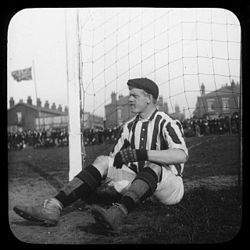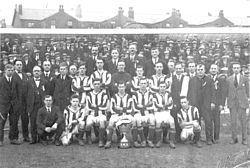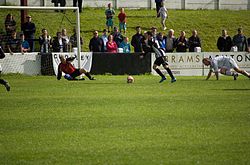- Chorley F.C.
-
Chorley F.C. 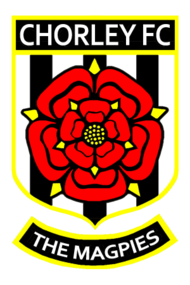
Full name Chorley Football Club Nickname(s) The Magpies Founded 1883 Ground Victory Park Stadium, Chorley
(Capacity: 4,100)Chairman Ken Wright Manager Garry Flitcroft League Northern Premier League Premier Division 2010–11 Northern Premier League Division One North, 3rd (promoted via play-offs) Home coloursAway coloursChorley Football Club are a football club from Chorley, Lancashire, England. They were founded as a rugby union club in 1875 but switched to football in 1883. They have reached the FA Cup second round twice in 1986–87 and 1990–91. Their best performance in the FA Trophy was in 1995–96 when they reached the semi-final. They will play in Premier Division of the Northern Premier League for the 2011–12 season; after promotion from NPL Division One via the play-offs.
Chorley are owned by Pontins owner Trevor Hemmings. Gerry Luczka succeeded ex-Everton, Bolton Wanderers and England Schoolboys player Paul Lodge as manager in October 2006. Gerry Luczka was succeeded by Tony Hesketh in February 2008, who resigned in April 2009 to manage Lancaster City.[1] Steve Waywell took charge for 2009–10 season, but following a poor end to the season he left the club by mutual consent and Garry Flitcroft, the former Manchester City and Blackburn Rovers player, was appointed to replace him. Garry had until just before the appointment been manager of rivals Leigh Genesis. Flitcroft promptly took the Magpies to Promotion in the First Division North Play-offs in his first season in charge
Contents
History
Chorley Football Club was formed in 1883 after switching from rugby to football.[2] In 1875 Chorley Football Club began partly as the brainchild of one Major John Lawrence, a Wigan player who had conceived the idea a year earlier. The inauguration took place on October 15 in the now demolished Anchor Inn in Market Street, Chorley. At that gathering Major Lawrence was elected the club's first captain. Henry Hibbert, who was to become one of the most famous figures ever connected with the town as Member of Parliament for Chorley,[3] took on the role of secretary. James Lawrence became the club treasurer.[4]
After playing rugby for seven years, pressure was on Chorley to switch to playing football instead, and in 1883 the switch was made. Chorley Football Club began with a win over Wigan in October 1883, and elected Major Lawrence as the club president in January 1884.[4]
Chorley joined the Lancashire Junior League in 1889, and the following year became a member of the Lancashire Alliance, a league which they were crowned champions of in 1892–93 and runners-up in 1893–94.[5] In 1894 Chorley joined the Lancashire League, becoming champions twice in 1896–97 and 1898–99.[5]
The Lancashire Junior Cup came to Chorley in 1894, nine years after the trophy's institution, and their win was the first of a record number of successes for the Magpies. They beat Clitheroe 3–2 in a replayed final at Ewood Park, Blackburn after a 2–2 draw.[4] Chorley bid farewell to the Lancashire Alliance at the end of the 1893–94 season and joined the Lancashire League, winning the championship in a 1896–97 which also saw them sell former Bolton Wanderers attacker Jack Lyden to Wolverhampton Wanderers for £100, a substantial fee for a non-league player considering that this was eight years prior to the first £1,000 transfer deal.[4]
Chorley won another championship in 1898–99, but was clouded by a notice to quit their Dole Lane Ground, and the loss of captain Johnny Parker, who had broken his leg. In May 1899 Chorley applied to join the Football League's Second Division, coming sixth in voting, with the top two being elected.[4]
September 1901 saw Chorley move to the Rangletts Ground, taking even the grandstand and hoardings, and 1903 saw the Lancashire League restructured as the Lancashire Combination, which was extended in size to encompass two divisions, A and B, with Chorley playing in the Combination B Division.[4] Life at the Rangletts Ground was short lived, with Chorley being evicted in 1904, and relocated to nearby St. George's Park. The 1904–05 season saw Chorley finish their highest position – fifth – for six years.[4]
Chorley suffered their worst season in 1914–15, finishing bottom of the league, but ironically the outbreak of the First World War saved them from relegation, for the Combination, like the Football League, suspended its competitions in 1915. During the war Chorley joined the Northern Division but due to difficulties in raising a team they were disbanded early in 1916.[4] Chorley did not have a team for the next two seasons, but in August 1918 formed a side for friendly matches. After the re-formation of the Combination S. Heaton became the club chairman, Charlie Holgate the secretary, and T. J. "Dod" Gaskell the treasurer.[4]
Chorley took their place in the reassembled Combination (there was only one division by now) with what proved to be one of their finest-ever teams. The 1920s were to bring a phrase of glory and the team was among the honours for ten successive seasons. But the beginning of one era coincided with the end of another. Just 14 years after playing their first home game at St. Georges Park, Chorley announced in August 1919 that they had acquired a new ground. It was to come into use the following year and was to be a truly permanent home. The ground, situated in Duke Street and adjoining Rangletts Recreation Ground, a former Magpie base, was named Victory Park to commemorate the end of the war.[4]
Chorley did not achieve notable success in any league until the 1919–20 season when they were crowned champions of the Lancashire Combination First Division, a league they won a total of eleven times between 1919 and 1964.[5]
In 1968–69 Chorley were one of the founder members of the Northern Premier League, left at the end of the season, and rejoined in the 1970–71 season.[6] Chorley joined the Cheshire League in the 1972–73 season, finishing as runners-up in 1975–76, and another two times in 1976–77 and 1981–82.[5]
Chorley rejoined the Northern Premier League in 1982–83, and became champions in 1987–88, which saw them promoted to the GM Vauxhall Conference – the fifth tier of the English football league system. Chorley spent two seasons in the GM Vauxhall Conference before being relegated back to the Northern Premier League in 1990–91.[2]
After a brief run of success in the FA Trophy in 1995–96, reaching the semi-final, and no significant success since their brief stay in the GM Vauxhall Conference, Chorley were relegated to the Northern Premier League Division One in 1999, where they remained until the 2006–07 season when they were relegated to the Northern Premier League Division One North Season 2010-11 saw them promoted to the Evo-Stik Premier League after a Play-Off Final at home versus AFC Fylde. After a string of managers in the 1990s and 2000s, coupled with no progression from the Northern Premier League, Chorley looked for a radical change by bringing in Tony Hesketh as manager in early 2008. Hesketh has used his experience to bring a degree of success gradually, despite financial difficulties. Hesketh believed in a passing game, and entertaining his side's supporters, and a run of five wins in eight games from Boxing Day 2008 brought fresh belief to Victory Park.
Tony Hesketh resigned as manager from the club in April 2009, citing poor resources as the reason. Assistant Manager Phil Brown took over as caretaker manager until the end of the season.[7] Chorley finished 14th out of 21 teams.
Ken Wright then appointed managerial duo of Steve Waywell and Lawrie "Lol" McMahon for the start of the 2009–10 season. Come mid-February the club was 10th in the league and still in touch of the play-offs, but only winning 3 of their last 16 games and picking up just 2 points in the final 8 games, Chorley finished 17th in the league, their worst finish in 3 seasons. This miserable record in the final third prompted Ken Wright to sack the pair at the end of the final game at Trafford.
Just over two weeks later on May 10, 2010, Ken Wright announced to the press that former Leigh Genesis high-profile manager Garry Flitcroft would take over the managerial reins at Chorley F.C. for the coming season.
Flitcroft's reign as Chorley manager started with Chorley's best ever start to a season, beating Woodley Sports 6–0, Curzon Ashton 6–2, Radcliffe Borough 4–1 and Prescot Cables 5–2. The 'Flitcroft Effect' has also brought more fans to Victory Park than in the past decade, with an average attendance across the first four home games of 631.
Flitcroft and Chorley's season finished with the team occupying 3rd place in the table and moved into the playoff semi-final with home advantage over 4th placed Curzon Ashton. The game ended 2–1 with goals from Dale Whitham and Adam Roscoe.
Chorley contested the Northern Premier League Division One North play-off Final against AFC Fylde on 6 May 2011 and after hitting the cross bar through midfielder Dale Whitham, took the lead halfway through the first half through striker Steve Foster. Chorley then came under pressure in the second half from Fylde as they looked for a way back into the game and went close through substitute Matt Walwyn, but Chris Howarth denied him an equaliser by saving with his feet. Chorley's next attack brought about the 2nd goal as Jack Dorney's 20th of the season flew in from a 25 yard strike in the 86th minute. The final whistle promptly sparked a pitch invasion and the majority of the crowd 2,950 saw Chorley lift the vase and celebrate promotion to the Northern Premier League Premier Division
Stadium
Victory Park 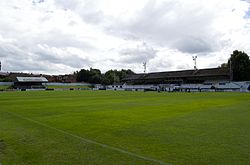
Victory ParkLocation Victory Park Stadium
Duke Street
Chorley
Lancashire
EnglandCoordinates 53°38′44″N 2°37′45″W / 53.64556°N 2.62917°WCoordinates: 53°38′44″N 2°37′45″W / 53.64556°N 2.62917°W Broke ground 1919 Opened 1920 Surface Grass Construction cost £868 (1919) Capacity 4,100 (900 seated) Tenants Chorley FC (1920–present) Chorley play at Victory Park, a stadium with a capacity of 4,100, of which 900 are seating. At a cost of £1,000, construction of Victory Park was completed in 1920 and was named to commemorate the end of the First World War.[8] The ground was very different to the Victory Park of today, as both ends of the ground were exposed to the weathers and there was no concrete terracing. The grandstand was a modest wooden structure with accommodation for 600.[4]
Chorley, with the aid of £654 raised by a special bazaar, bought Victory Park in 1926 for £868. The Supporters' Club provided £100.[4]
In November 1945 a fire broke out and destroyed the main wooden stand shortly after it had been vacated following an FA Cup tie against Accrington Stanley,[9] which had been attended by a crowd of 4,019. The stand was practically destroyed and gutted all but the dressing rooms, and the efforts of firemen could not prevent the loss of valuable property, equipment and playing kit. Work on the new grandstand began in 1947, costing £5,500 – five and a half times the price of the original one.[4]
Capacity: 4,100
Seating: 900
Covered capacity: 2,800Average attendances
2010–11: 756
2009–10: 271[10]
2008–09: 264[10]
2008–09: 263
2007–08: 343
2006–07: 230
2005–06: 195
2004–05: 207Statistics and records
Peter Watson holds the record for the highest number of goals scored in a single season with 71 (57 league goals) in the 1960/61 season.[11] Peter Watson also holds the highest aggregate goalscorer record of 372 (287 league, 85 cup) between September 1958 and February 1966.[11]
The club's widest victory margin was their 14–1 home win against Morecambe in April 1946.[11] Their widest victory margin during wartime was 16–0 against Leyland Motors in September 1944.[11]
Chorley's record attendance was 15,153 v Preston North End in the FA Cup, played at Ewood Park, home of Blackburn Rovers on December 6, 1986.[11] At Victory Park Chorley's record attendance was 9,679 in a FA Cup 4th qualifying round match against Darwen on November 15, 1932.[8]
Squad 2011–12
As of 07 October 2011
Note: Flags indicate national team as has been defined under FIFA eligibility rules. Players may hold more than one non-FIFA nationality.
No. Position Player 
GK Chris Howarth 
GK Dean Porter 
GK Russell Saunders 
DF Ali Brown 
DF Tom Walker 
DF Wayne Maden 
DF Jonathan Smith 
DF Andy Russell 
DF Andrew Teague 
DF Mark Ross 
MF Jamie Vermiglio 
MF Steve Flitcroft No. Position Player 
MF Dale Whitham 
MF Nathan Fairhurst 
MF Tom Ince 
MF Tom Williams 
MF Simon Whaley 
MF Shelton Payne 
FW Adam Roscoe 
FW Matt Jansen 
FW Chris Denham 
FW Steve Foster 
FW Lee McEvilly 
FW John Cunliffe Club officials
As of October 2010[12]
Chorley Football Club
- Chairman: Ken Wright
- Vice-Chairman: Brian Pilkington
- Directors: Tony Garner, Geoff Haslam, Graham Watkinson
- Social Club Manager: Christine Haslam
- Club Secretary: Harold Taylor
- Safety Officer: Grenville Hartley
- Chief Steward: Geoff Haslam
- Commercial Director - John Derbyshire
- Commercial Representative - Mark West
- Turnstile Supervisor - John Moore
- Programme Editor/Webmaster: Mark Locke
Coaching and Medical Staff
- Manager - Garry Flitcroft
- Assistant Manager - Matt Jansen
- Physio - Beverley Webster
- Club Captain - Andy Teague
- Kit Manager - Jonathan Gains
Notable former players
 Charlie Ashcroft
Charlie Ashcroft Lee Ashcroft
Lee Ashcroft Graham Barrow
Graham Barrow Gary Briggs
Gary Briggs Gary Buckley
Gary Buckley Stan Howard
Stan Howard Tommy Lawrence
Tommy Lawrence Paul Mariner
Paul Mariner Gary Pierce
Gary Pierce Brian Pilkington
Brian Pilkington Ray Redshaw
Ray Redshaw Shaun Teale
Shaun Teale Lee Trundle
Lee Trundle Geoff Twentyman Jr
Geoff Twentyman Jr Mickey Walsh
Mickey Walsh Steve Williams
Steve Williams Frank Worthington
Frank Worthington Tony Clegg
Tony Clegg
Achievements
- Northern Premier League
- Lancashire Combination
- Cheshire League
- Runners-up 1975–76, 1976–77, 1981–82[5]
- Lancashire League
- Champions 1896–97, 1898–99
- Lancashire FA Trophy
- Winners 1894, 1909, 1924, 1940, 1946, 1958, 1959, 1961. 1964, 1965, 1976, 1980, 1982, 1983
- Runners-up 2008
References
- ^ http://www.chorley-guardian.co.uk/sport/Why-I-had-to-leave.5150363.jp
- ^ a b http://chorley.sponsor-link.tv/content.php?page=2%20history
- ^ http://hansard.millbanksystems.com/people/sir-henry-hibbert
- ^ a b c d e f g h i j k l m ""In Black & White"" Chorley Football Club's Official History by John F. Newman.
- ^ a b c d e http://chorley.sponsor-link.tv/content.php?page=4%20league
- ^ http://www.fchd.info/CHORLEY.HTM
- ^ 22
- ^ a b http://chorley.sponsor-link.tv/content.php?page=3%20ground
- ^ http://www.bbc.co.uk/london/content/articles/2008/10/06/nl_ground_chorley_feature.shtml
- ^ a b http://www.mikeavery.co.uk/ATTN.%20GRIDS/8NPLD1Ncrowds.htm
- ^ a b c d e ""The official match programme of Chorley Football Club"". Chorley Football Club – with passion we strive - 10-03-2009.
- ^ http://www.chorleyfc.com/index.php?option=com_content&view=article&id=6&Itemid=9
External links
Categories:- Sport in Chorley
- English football clubs
- Northern Premier League clubs
- Association football clubs established in 1875
- Lancashire Combination
Wikimedia Foundation. 2010.

